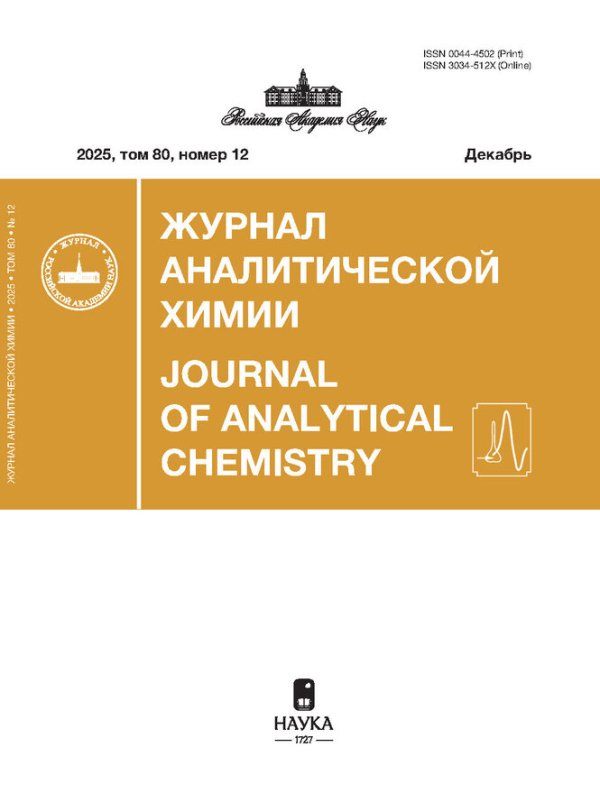Vol 78, No 3 (2023)
REVIEWS
 195-207
195-207


ORIGINAL ARTICLES
A Thin Layer Method for the LA-ICP-MS Analysis of Trace Element Concentrates
Abstract
A method is proposed for the analysis of trace element concentrates by a thin layer method in combination with inductively coupled plasma mass spectrometry (ICP-MS) and laser ablation (LA). Trace elements concentrates were evaporated on preliminarily prepared areas of a high-purity silicon substrate, after which an LA-ICP-MS analysis was performed. The influence of the LA parameters and the conditions for recording the spectra on the signal of the analytes and the substrate material was studied. The analytical capabilities of the thin layer method in combination with LA-ICP-MS for the analysis of high-purity substances with the preconcentration of trace elements were evaluated. Using an analysis of high-purity nitric acid as an example, it was shown that the limits of detection for analytes in the LA-ICP-MS analysis of trace element concentrates using the thin layer method are in the range from n × 10–11 to n × 10–8 wt %. Thus, the development of combined procedures of analysis, including the preconcentration of trace elements and an analysis of concentrates by LA-ICP-MS, makes it possible to reduce the limits of detection for most analytes by one order of magnitude compared to instrumental ICP-MS analysis.
 208-215
208-215


Analysis of Small-Mass Biological Samples by ICP MS Using Microwave Acid Digestion of Several Samples in the Common Atmosphere of a Standard Autoclave
Abstract
To expand the available tools for the analysis of samples of biological and plant origin of small mass (10–20 mg) using ICP MS, we developed a construction made of three compact teflon reaction minivessels (inserts) of an internal volume of 3 mL, placed in a standard autoclave (EasyPrep) of a volume of 100 cm3 of a MARS-5 microwave system (CEM). The acid digestion of samples in reaction minivessels requires no more than 1.5 mL of highly pure acids. The digestion of samples proceeds in the common gas atmosphere of a standard autoclave filled with a needed volume of acids of pure for analysis grade. The method was tested on reference materials of plants and biological sample. The results obtained are in agreement with the certified values. The developed method ensures the decrease of the detection limits and obtaining new data on the concentrations of B, Ga, Y, Nb, Tl, Bi, and a number of rare-earth elements in the reference materials.
 216-222
216-222


Monitor Calibrator as an Alternative to Spectrofluorimeter: Determination of Quinine in Beverages and Medicinal Preparations
Abstract
A possibility of using a monitor calibrator for the determination of luminescent compounds is shown on an example of quinine. The determination is based on the irradiation of a sample with broadband radiation in the visible and near UV spectral regions from a built-in source exciting phosphor molecules and the simultaneous registration of the radiation incident on the detector. Measurement conditions are selected. Quinine can be determined in the range of 60−750 µM, the limit of detection is 20 µM. The determination is not affected by common inorganic ions, as well as sweeteners and acidity regulators present in many beverages. The developed method of determination is applicable to the analysis of carbonated drinks and drugs. Compared to a traditional spectrofluorimeter, monitor calibrator is characterized by compactness, mobility, ability of detecting luminescence in cuvettes of various sizes and shapes, and lower cost.
 223-230
223-230


Determination of Viscosity Improvers and Detergent Additives in Synthetic Motor Oils by Gel Permeation Chromatography
Abstract
We proposed a procedure for the simultaneous determination of viscosity improvers and detergent additives in synthetic oils by gel permeation chromatography, including the preliminary liquid extraction of polar additives, solid-phase extraction of polymer additives on silica modified with magnesium oxide from oil raffinate, and the subsequent determination of analytes. The procedure was used to determine viscosity improvers and detergent additives in fresh and used synthetic motor oils, to control the quality of oils at different stages of operation, and to monitor the degree of purification of oils during their regeneration. In-process monitoring of additive concentrations during the operation of automotive equipment enables the timely control of the dynamics of engine oil degradation throughout its use and proper recommendations for its replacement in the system. The procedure was tested in the analysis of fresh and used multigrade synthetic motor oils Shell Helix Ultra 5W-30 and TP MAX Total 10W-40 and fresh multigrade synthetic motor oil Shell Rimula R5M 10W-40.
 231-240
231-240


Multilayer Coatings Based On Citrate-Stabilized Gold Nanoparticles and Polydiallyldimethylammonium Chloride for the Electrophoretic Separation of Carboxylic Acids
Abstract
The conditions for the formation of physically adsorbed three-layer coatings of quartz capillary walls in capillary electrophoresis (CE) with successively deposited oppositely charged layers of polydiallyldimethylammonium chloride (PDADMAC) modifiers and citrate-stabilized gold nanoparticles (GNPs) are proposed. It was shown that three-layer PDADMAC–GNP–PDADMAC coatings favorably differ from monolayer coatings with PDADMAC by greater stability in a wide range of pH (2–10). The formed coatings were characterized by scanning electron microscopy, and the presence of a uniform dense layer of nanoparticles on the capillary surface was confirmed. The applicability of the modified capillaries under CE conditions was demonstrated by the separation of a mixture of 16 carboxylic acids. An increase in the separation selectivity achieved with the use of three-layer coatings based on GNPs was explained by the reversible exchange of citrate anions on the GNP surface with negatively charged analytes in the course of electrophoretic analysis.
 241-252
241-252


Sequential Injection Amperometric Determination of Glucose in Saliva Using a Screen-Printed Electrode Modified with a Gold–Cobalt Binary System
Abstract
The catalytic activity of particles of gold, cobalt, and a gold–cobalt binary system electrodeposited on the surface of planar carbon electrodes was found in the oxidation of glucose in a neutral medium. The amperometric response of a screen-printed electrode modified with a gold–cobalt binary system was used as an analytical signal in the determination of glucose in a sequential injection system. The linear logarithmic dependence of current on the glucose concentration was observed in the range from 5 × 10–8 to 5 × 10–2 M. The use of a screen-printed electrode modified with a gold–cobalt binary system as an amperometric detector in a sequential injection system makes it possible to selectively determine glucose in saliva in the concentration range used for medical diagnosis.
 253-259
253-259


Determination of 6-Nitro-7-(4'-Nitrophenyl)-5-Ethyl-4,7-Dihydropyrazolo[1,5-a]Pyrimidine-3-Carboxylate as a Potential Antitumor Agent by Voltammetry
Abstract
6-Nitro-7-(4'-nitrophenyl)-5-ethyl-4,7-dihydropyrazolo[1,5-a]pyrimidine-3-carboxylate (1) is one of promising antitumor compounds exhibiting biological activity against type 2 casein kinase, which is currently considered as a promising target in chemotherapy. Using the method of cyclic voltammetry, it was shown that the electrochemical activity of compound 1 in a mixed solution of Tris-HCl and ethanol (1 : 1) at pH 7.5 on a glassy-carbon electrode is due to the electrochemical reduction of the nitro group conjugated with the phenyl ring. A method was developed for the determination of compound 1 by direct cathodic square-wave voltammetry. The linearity region of the corresponding calibration curve obtained in a solution of a mixture of Tris-HCl and ethanol (1 : 1) at pH 7.5 is 5–500 mg/L (R2 = 0.988), the limit of detection is 0.8 mg/L, the limit of quantification is 2.4 mg/L. The accuracy of the developed procedure is close to 100%, the relative standard deviation is 1.4%.
 260-267
260-267


Determination of Methane Dissolved in Water Using Metal-Oxide Sensors
Abstract
The method for the determination of dissolved methane in water using the system based on a tubular selective membrane permeable to volatile organic substances and impermeable to liquid water is proposed. Purified air is passed through the membrane tube immersed in water. The air inside the tube is saturated with methane dissolved in water, which diffuses through the tube wall. Methane concentration is measured in the air passing through the membrane tube using a semiconductor metal oxide sensor. The sensitivity threshold and the response time of the system are estimated.
 268-273
268-273


Evaluation of a Possibility of the Application of “Electronic Nose” to Monitoring Deviations in the Functional Obesity of Children in Hospital Conditions: Observations of Changes during Treatment
Abstract
This work is a continuation of a study on the use of chemical gas sensors and a portable “electronic nose” for diagnosing obesity and related pathologies in children in a hospital. Using a portable Bio-8 device, 330 volatile skin compound profiles were measured in the forearm region on an empty stomach in various states of children with various diseases during inpatient examinations and treatment in the endocrinology department. Monitoring changes in the profile of volatile skin compounds during the period of hospital stay in obese children made it possible to identify priority metabolic disorders in multiple pathological disorders and diagnoses by a characteristic set of chemical biomerkers of processes, reliably detected in skin secretions on the right forearm. Multiparametric data of the “electronic nose” were processed by principal component analysis to assess ranking of the results into the groups “Normal” and “Obesity with a risk of the development of type 2 diabetes mellitus (DM)”. Based on the highly informative parameters of the sensor array, changes in the chemical composition of the skin gas profile on the right forearm during the period of patients’ stay in the hospital and the effectiveness of standard approaches in each specific case were evaluated, and the personalization of treatment was thus increased. Simple calculated parameters and a method for assessing lipid and carbohydrate metabolism disorders based on the signals of eight sensors above the skin measured for 200 s without sampling were proposed. The sensitivity of the method for monitoring changes in the metabolome in a hospital is at least 80%. Specificity for lipid metabolism disorders is 100%; for type 1 diabetes, 100%; and for mixed pathologies varies from 70 to 85%.
 274-287
274-287


CRITIQUE AND BIBLIOGRAPHY
Новые книги издательства JOHN WILEY & SONS, LTD
 288
288













